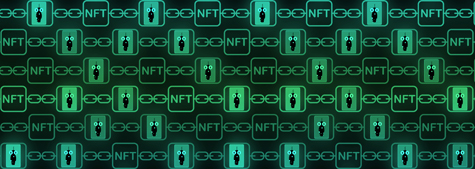What exactly are non-fungible tokens and why are they taking the internet by storm? Here’s a closer look at NFTs and how they work.

What are NFTs
Just when you thought the hype around bitcoin was starting to level off, a new player appears to have entered the cryptocurrency arena and is now being dubbed the new frontier of the crypto gold rush.
It all started with a piece of art that sold for more than $88 million via the renowned Christie’s auction house. However, the winning bidder did not purchase a print or a painting, but a digital art piece that only exists in the ether – they will receive a unique digital token known as an NFT.
Non-fungible tokens, or NFTs, are the latest crypto phenomenon that has gone mainstream overnight. NTFs are digital assets built on the same blockchain technology as bitcoin and ethereum. But unlike cryptocurrencies, they cannot be traded or exchanged at equivalency. The tokens are unique asset identifiers that are considered to be non-fungible because they cannot be forged, replicated or divided.
The internet’s newest, and arguably most confusing, asset is leaving investors (as well as people in the internet) scratching their heads. What exactly is an NFT and how does it work?
What is a non-fungible token (NFT)?
Let’s break down the basics on this new digital asset.
As we’ve mentioned, NFT stands for non-fungible token. In economics, a fungible asset means that it’s exchangeable, like money. For example, you can trade a $20 note for four $5 notes and it will be of equal value.
This, however, doesn’t apply to a non-fungible asset, which has unique properties, meaning it cannot be interchanged with something else. This is because NFTs are unique and each one is one of a kind. For example, traditional works of art such as Da Vinci’s Mona Lisa or Van Gogh’s The Starry Night are considered as non-fungible. While you can make copies of them by taking a picture or buying a print, there will always be only one original and authentic painting.
While art paintings are one of a kind, digital forms of art (including audio, videos and drawings) can be easily and endlessly duplicated. They can be seen, screencapped and downloaded by anyone online.
This is where NFTs come in. They function as a non-duplicable digital certificate of ownership for any assigned digital asset. It is basically a contract that is assembled using bits of open source code and used to secure a digital item. Once the code is created, it is then minted and then published into a token on a blockchain.
How do NFTs work?
NFTs are unique collectible tokens that are permanently tied to a specific digital asset. It is a form of digital asset whose ownership is recorded on a blockchain.
What’s a blockchain?
If you’re an intermediate crypto trader, you may be highly familiar with this. But those that are new to it may think of it as a digital ledger that keeps a publicly accessible record of who owns what asset, similar to the kinds of networks that are behind bitcoin. Most NFTs are part of the ethereum blockchain, where the ownership and transaction history of each unique NFT are stored.
So, NFT tokens can be considered as digital passports. Each token has a unique and non-transferable identity to differentiate it from other tokens. Because of this, it can’t be replicated. Similar to bitcoin, NFTs contain ownership details for identification and easy transfer between token holders. Like cryptocurrencies, they also have no tangible form of their own.
Once it is purchased, the owner of the NFT has the digital rights to resell, distribute or license the digital asset at their own discretion. The only limitation is that the creator can program, in the conditions in the NTF’s code, how it gets used. For example, they can bar it from being displayed on a certain platform, such as a streaming network or a TV network. NFT creators can also earn royalties from future reselling transactions.
What can I turn into an NFT?
Digital artworks are particularly marketable as a unique collectible when published as an NFT. The sudden rise in popularity of NFTs came from a string of artists, influencers and musicians that have recently started striking gold by selling NFT versions of their digital art, as investors and collectors line up to get their hands (virtually) on them.
But are NFTs only for artworks? No. Almost any digital collectible can be converted into an NFT. You can turn real estate, online trading cards, GIFs, memes and even video game costumes into an NFT. In fact, the possibilities are endless – Twitter co-founder and CEO Jack Dorsey’s first tweet was turned into an NFT and was sold at an auction for $3.8 million.
World-renowned brands such as Nike, Louis Vuitton and the NBA have already started generating NFT-based consumer goods and services. The most popular NFT platform, NBA Topshot, has sold almost $349 million worth of unique NBA video highlights. In Australia, start-up Zora is attempting to cash in on this new digital economy by embarking on a journey to create a sustainable marketplace for creators by using NFTs.
To purchase an NFT, buyers must figure out what cryptocurrency is needed for the transaction, then purchase the cryptocurrency then create a digital wallet for the transaction. While ethereum is one of the most popular currencies for NFT transactions, each platform chooses its digital wallet service. Make sure to do your research before purchasing your digital currencies.
Once you’ve covered this step, you can start looking for NFTs to purchase in digital marketplaces such as OpenSea, Rarible and Mintable.
Be careful about buying cryptocurrencies and make sure that you are buying from a reputable crypto exchange.
Is NFT a good investment?
With all this said, should you invest in NFTs? NFTs gain value from the same deflationary principles as bitcoin – there is a limited number of tokens and the item is unique and cannot be duplicated.
Additionally, an NFT’s value is based on how well-received the item is by people who want to purchase it. If an item is highly desirable, its value will understandably go up.
People purchase NFTs for different reasons. It can be a financial investment, a sentimental purchase or a way for a buyer to support an NFT creator, like an artist or a musician. Think of it as people collecting sports trading cards or vintage toys.
But because NFTs are a relatively new asset, there is still a lot to learn about them. Additionally, it can be difficult to put a price on a digital art, making it an incredibly risky investment. After all, there are no guidelines on how much a meme or GIF is worth, so there’s a lot of guesstimating involved on how much you’ll be able to profit from it, or whether you will be able to sell it at all.
But if you want to be part of the so-called NFT gold rush, it’s advised to set a spending limit and only spend what you can afford to lose. NFTs are highly speculative, so don’t dive into it with the expectation of getting millions of dollars in one transaction. It may be better to keep the majority of your money in safer investments, such as index funds or ETFs. This will put you in a better position to take on risky investments.
While NFTs are an interesting new type of investment, it doesn’t mean they’re right for everyone. If you’re determined to be part of the hype, it may not hurt to explore this asset and buy one or two that catch your interest. Otherwise, it’s a good idea to watch this crypto phenomenon unfold from the sidelines where your money will be safe.
Zarah Mae Torrazo
March 30 2021
nestegg.com.au























